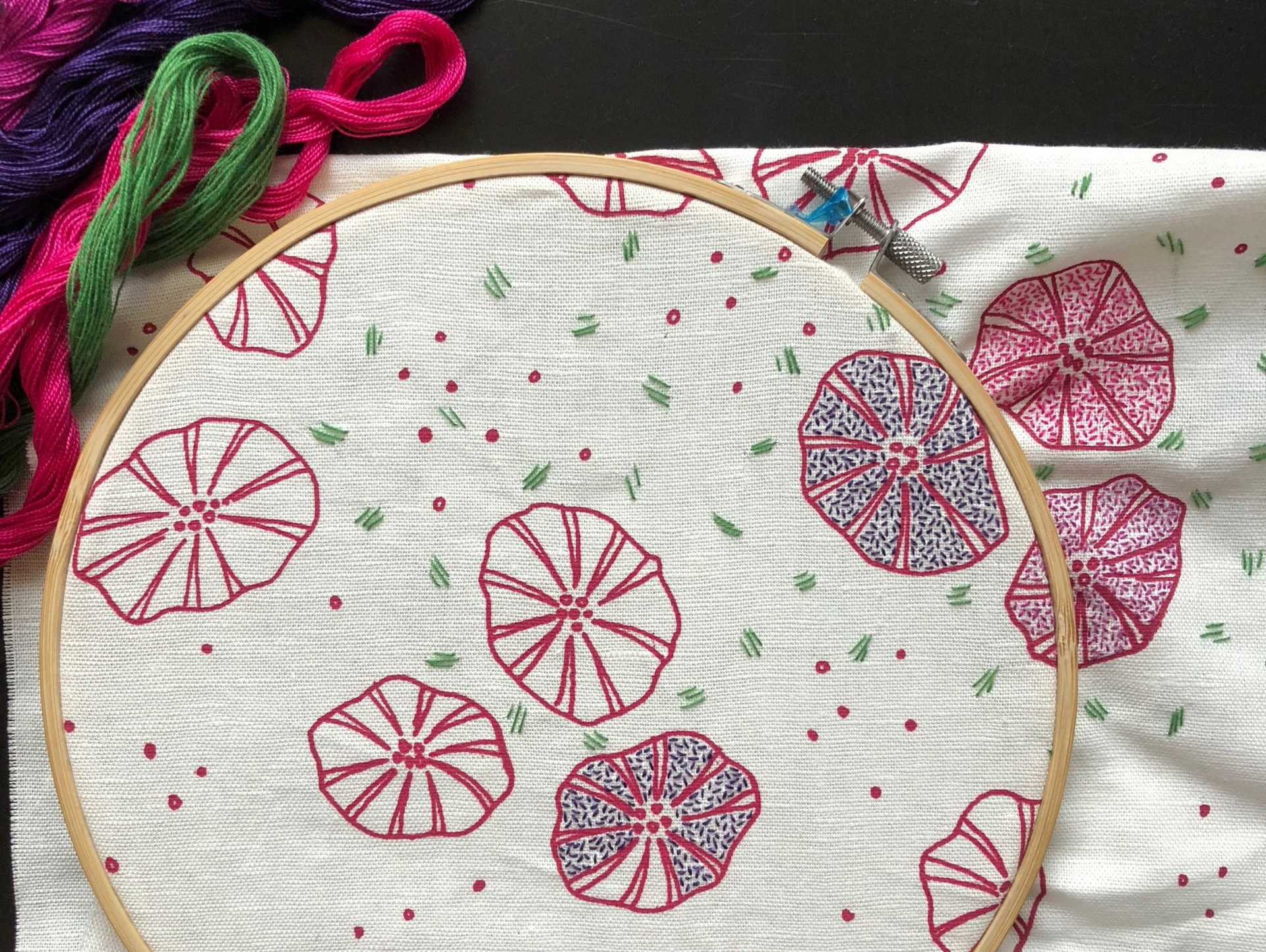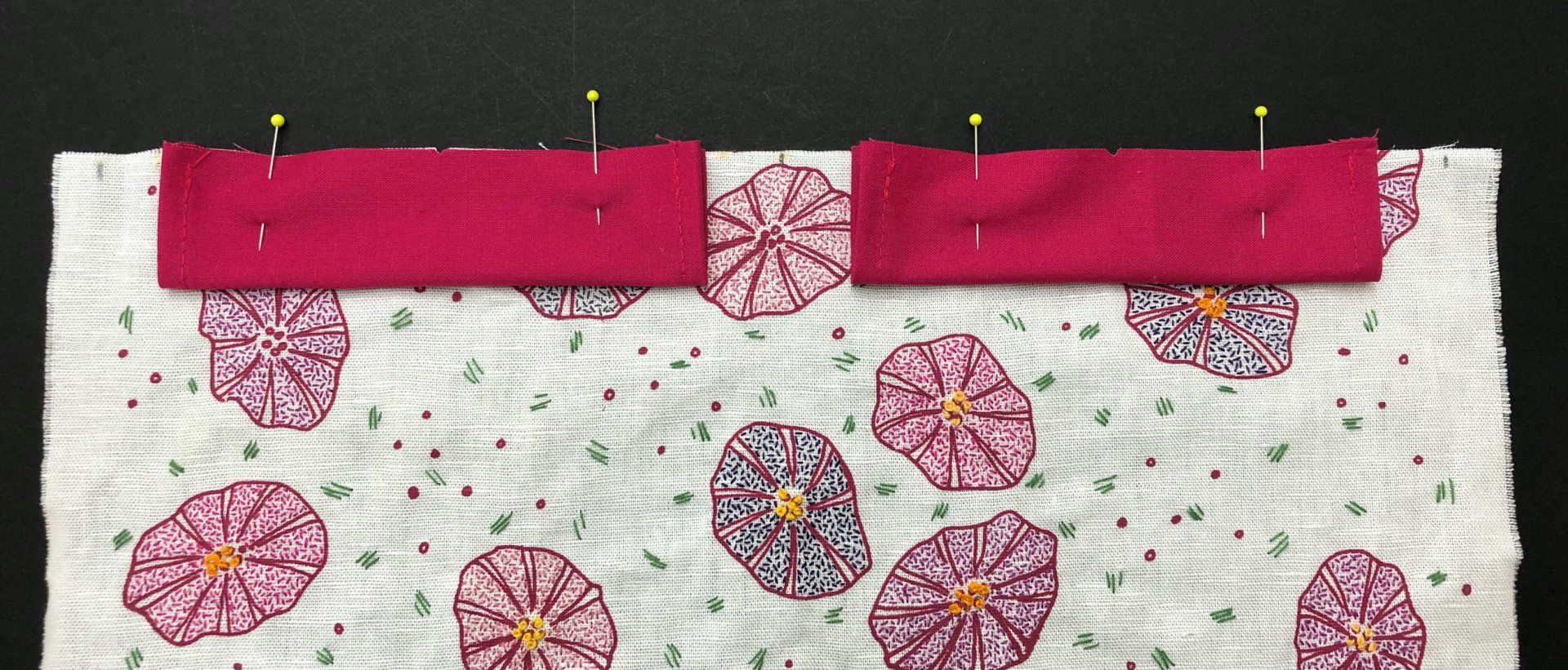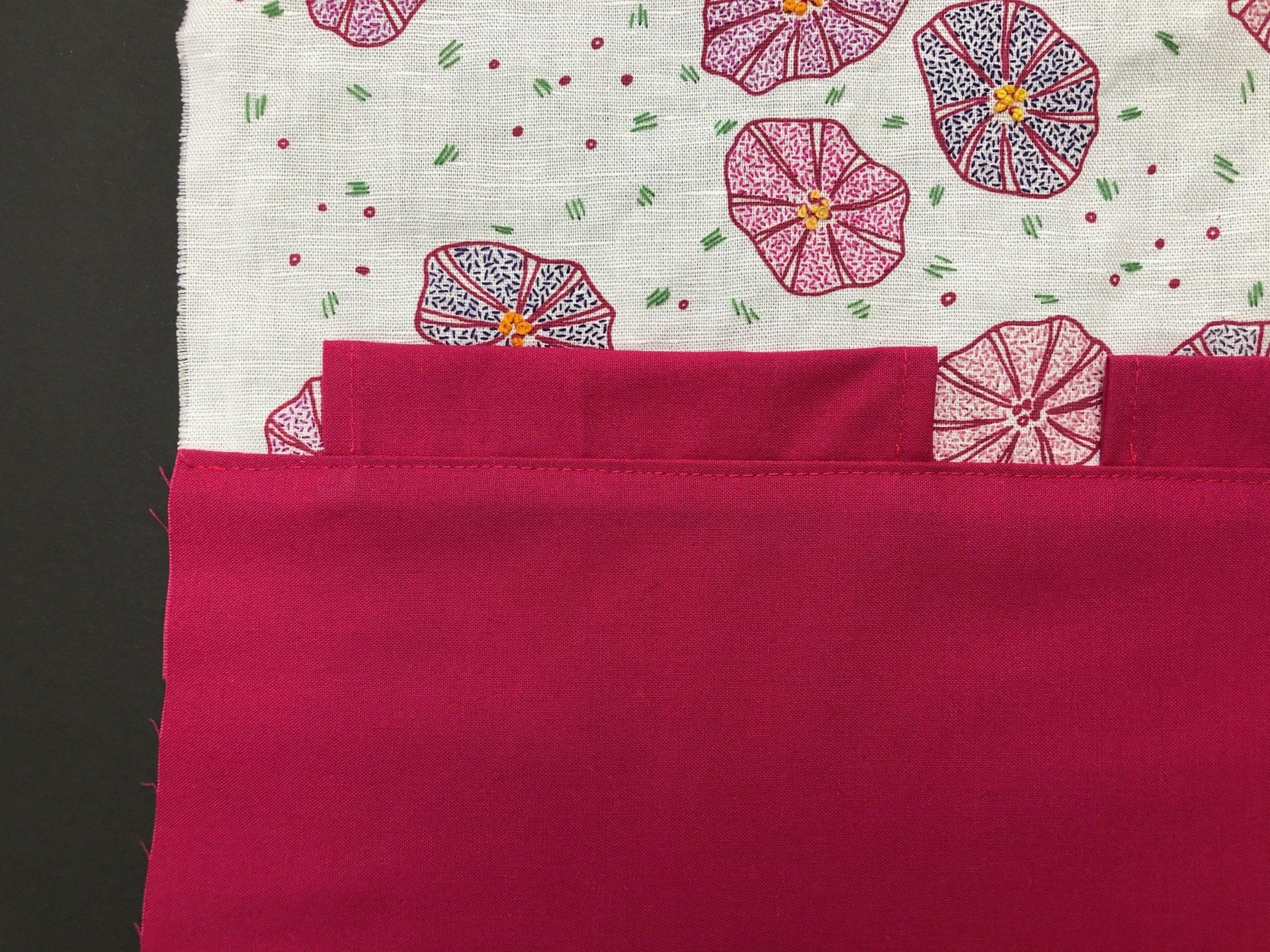Drawstring Bag Tutorial
Drawstring Bag Tutorial

This little drawstring bag is the perfect size for a book or your chargers / a kindle etc. I have made this using half of one of my screen printed panels, you can easily adjust the measurements based on the fabric you have to hand.
I embroidered half of the panel using some single strand fine cotton threads and filled the flowers with seed stitch. I added French Knots to the centre of the flowers and some green stitches to add some colour to the background. If you want to embroider your fabric, do so before making the bag.
I chose a darker lining for this bag as the green strands of thread on the back of the work showed through the front when placed on a lighter backing. Try laying your embroidered piece on different linings before cutting anything to size.
This drawstring bag measures 17cm x 25cm.
You Will Need:
Outer fabric - 36 x 25.5cm
Lining fabric - 36 x 25.5cm
Two tabs - 16 x 7cm
Ribbon or narrow cord - 1 metre
Embroidery threads to add decorative stitches - optional
1cm seam allowance throughout.
Begin by folding and pressing the short ends of the tabs in by 1cm, ensure both tabs are the same finished length. Turn under raw edge by 0.5cm and stitch down. (See photo above on right)
Now mark out some key notches on the top edge of the outer fabric using a fabric pencil / tailor's chalk.
Mark your seam allowance, 1cm from the left and right outer edges, SA on image.
Mark the halfway point of the outer fabric, H on image.
Fold the outer seam allowance SA mark to the halfway H point, this will give you the centre of your finished pouch, C on image.
Fold along the long edges of your tabs to find the centre point, C on image.
Fold your tabs in half lengthways. Line up the centre point of the tabs with the centre point of the outer panel and pin both tabs in place.
Lay the lining on top, right sides together and pin along the top edge.
Stitch along the top to secure the outer layer, the tabs and the lining together.
Open out, press the seams to the lining and then top stitch the lining to the seam allowance.
Fold your bag in half with the outer facing the outer and the lining facing the lining, right sides together. Line up the join seam and pin, then pin around the rest of the bag.
Stitch all the way around the bag leaving a gap at the bottom of the lining to turn the bag through.
Turn the bag through, press and stitch the lining closed.
Take two 50cm lengths of ribbon or narrow cord. Thread one piece through both tabs and knot both ends together, repeat with the other ribbon starting from the opposite side.
If you want to make this bag in different sizes it's very easy to adjust the measurements, by using the method above to mark out your notches you'll always have your tabs central to your bag.
Aim for the tabs to finish 1.5 or 2 cm from either edge of the finished bag, this allows for the bulk of the ribbon / cord.
I hope you've enjoyed making this simple bag, it's great for storing all sorts of items, but would also make a lovely gift, why not pop in a book and send it to a friend.
If you've enjoyed making this, please share with friends and credit Colette Moscrop for the pattern. I'd love to see your versions, use #ColetteMoscropTextiles on social media and I can find your projects.
share with a friend

I'm often asked how to patchwork fabrics together to a specific size, such as when you may be making a purse / bag / Fabric Bucket etc. Using a solid piece of fabric is always an option, but it's more interesting to piece together your favourite fabrics to make your finished item more personal to you. I've put together this guide to help you, I often work in an improvisational style, as I like to play around with pattern and scale until I'm happy with the finished composition. * This tutorial does assume you know how to cut and trim fabrics with a cutting mat, acrylic ruler and rotary cutter, if you've not used these before, a quick web search will help you out. *

If you've seen my work at a show you'll already know that I'm all about the texture of a project. I love to use natural fibres and threads to build up a range of texture. I thought I'd share some images to inspire you to take the plunge and add some freestyle stitches to your projects. The first thing I usually add to my work is a layer of cotton wadding (batting) to the reverse of the fabric I'm going to be stitching on. I baste this (large tacking stitches) with a brightly coloured thread so it's easy to spot when I'm ready to remove it. You may have some wadding left over from quilt projects, if not try your local quilt shop / online stockist. Then it's time for the fun part, slow stitching and adding your personality to your work. I am no expert at embroidery, I simply draw and sketch with a needle and thread. I'm not looking for perfection and neat regular stitches, for me it's about the process. Enjoying the time it takes to stitch and seeing where the needle takes me. I don't plan my pieces before I start, I choose a couple of threads and dive in. If you're new to embroidery, here are a few tutorials to give you some guidance, Royal School of Needlework Stitchbank , DMC and The Spruce Crafts .

I thought I'd share with you some images of the Japanese Rice Bag I made earlier in the year. This project was one of the most soothing I've worked on as it was such a simple make with beautiful results. I carefully chose my favoutite colours and prints, hand stitched in the garden over the summer and let my mind wander as I stitched freely, waiting to see what came next.

I'm a big fan of simple blocks and shapes when it comes to quilting, I like to see the print of the fabric and I like to add a solid colour to give the eye somewhere to rest and create a strong statement. I've recently finished making 2 cushions using HST's and I thought I'd share my process with you. For both cushions I used fabric panels from my shop . You don't have to use the same prints or colours, choose something that will compliment your home decor.

This bunting has pockets to fill with treats and festive challenges for your little ones on the run up to Christmas. You can make a long piece or break in into smaller sections depending on where you want to hang it in your home. You will need: 1 advent calendar panel 1.25m – 1.5m co-ordinating solid fabric (see point 8 below) Scissors / rotary cutter and mat / quilt ruler Thread Fabric marker – tailor’s chalk / fabric pencil, tape measure Cutting: cut along the red grid of your advent panel to give you 25 individual number squares. cut 25 squares of red fabric measuring 9.5 cm x 9.5cm cut 50 rectangles of fabric measuring 9.5cm x 14cm cut 4cm x length(s) you require for your bunting. (see point 8 below) If you want to decorate your number panels, do so before stitching up your bunting pockets, be sure to leave at least 1cm clear of the edges for seam allowance. 1 – right sides together, join a red square and a number square, stitching across the top edge with a 5mm seam allowance. 2 – from the wrong side, press the seam allowance towards the red fabric, then fold and press the red to the back of the number square. This will create the front of your pocket.













